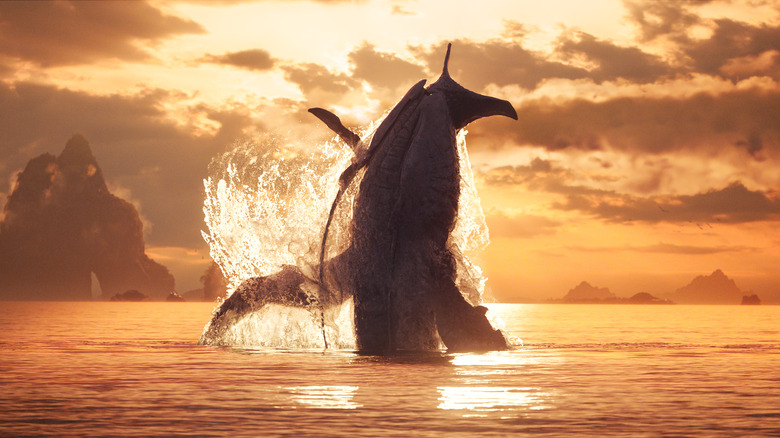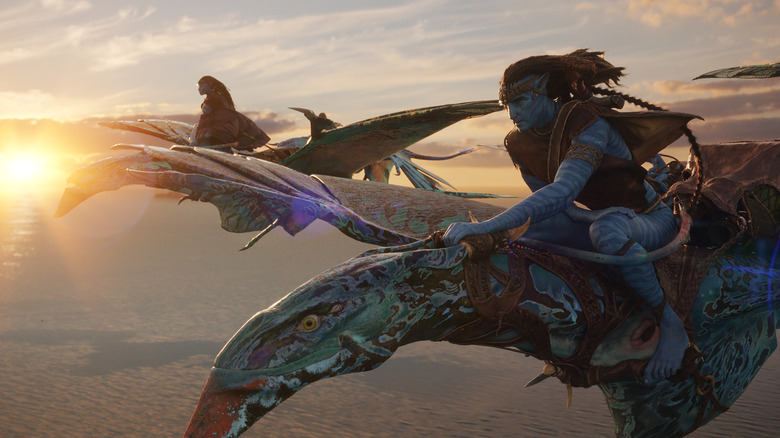Creating The VFX For Avatar: The Way Of Water In 3D And HFR Was A Unique Challenge
I am someone who no longer finds much wonder and awe in visual effects. The cinematic landscape, particularly on the Hollywood blockbuster side, is so overwhelmed by the omnipresence of digital environments and characters that it becomes mush to me, especially now that digital effects artists are being overworked and underpaid to a disgusting degree. It's an art form that doesn't get the opportunity to shine because of the time and money allotted to them.
Then there's "Avatar: The Way of Water."
Throughout the three-plus hours I spent watching James Cameron's latest epic, I found myself truly in disbelief about how he and his effects team were able to create things I had never seen before and felt were entirely real. Even more impressive was that this was done in 3D, a format that misses with far more regularity than it hits, and high frame rate, a filmmaking technique still in the early years of development that a good percentage of people actively detest (wrongly detest, in my opinion).
The impact of the effects cannot be unlinked from the film's use of these two formats. The 3D and HFR require there to be no visible seams in the effects, but those formats also need to be integrated into the look of the film in a way that can enhance the beauty of the effects. Finding that marriage isn't easy and required an acute attention to detail and the time needed to get everything looking just right so I could go to a theater on opening day and be utterly blown away wearing those IMAX 3D glasses.
It's all about focus
Having your film be in 3D isn't just an effect you put on the movie. So many of those post-converted 3D cash-ins we saw after the first "Avatar" film prove that all too well. No, 3D dictates so much about how you shoot your film. At a press conference attended by /Film, the producer of "Avatar: The Way of Water," Jon Landau, said of their approach:
"[T]he key for good 3D is for us to make sure it's sustainable for the three hours, the length of the movie. It can be very easy to be seduced by the novelty of 3D and push back and forth or throw objects at the camera. That's not us at all. We tried to integrate it as part of our visual language."
Done improperly, 3D can cause immense eye strain, especially with such a long runtime. The key is focus, and with 3D, focus is a little more complicated. Richie Baneham, the VFX supervisor for Lightstorm, explained that creating that focus requires finding the right convergence point of the two cameras:
"We tried to converge the two cameras where we believe the audience is gonna look. What do we do as filmmakers? We wanna instruct you where to look. In a 2D movie, you do that by motion, you do that by lighting, you do that by focus ... 3D is just another tool that helps guide you. So, we try to define, where is someone gonna look? And that's where we converge our two cameras and let everything play as depth behind it."
When you are creating what is essentially an entirely virtual world, finding that right convergence point requires a lot of trial and error, and the end results are a testament to that time spent.
No cheating
Another hurdle you have with 3D is a lot less room for error. In a typical 2D film, you are able to hide some of the seams of your effects because you are working with a flat image. These are cheats that go all the way back to classic hand-drawn animation, where the lack of dimensionality allows for cutting corners on movement and contact. With a fully 3D image, you can't do these things, as senior VFX supervisor Joe Letteri said in the press conference:
"[I]f you've got a character walking on the ground, the foot contacts have to be perfect. In a 2D movie, you can cheat a little bit. But in a 3D movie, you just can't. So, there's a lot more work, you know, that goes into it. And also, you have to think about how the cut flows. Like, you might get a shot perfect and you work on a bunch of shots and you've got some really hard ones and they take longer. And then you watch it in the cut and you realize, to Jon's point, that now across the cut, you're not looking where you should be looking. And so, you have gotta go back in and rework the shots for the stereo so that it plays comfortably across the whole scene."
Because you have so much less room for error, every department must be working at the top of their game to accomplish this. Stereoscopic 3D may be a technology that has been around for quite some time now, but that doesn't mean it can be taken for granted. "Avatar" was basically the only movie people agreed made proper use of the technology. Its sequel would need to refine it even more. And this is before we get to HFR.
Double the render, double the frame rate
High frame rate has been a much maligned technology since Peter Jackson first used it for "The Hobbit: An Unexpected Journey." Some liken it to motion smoothing on your television. Some think the people move too fast. Some think it looks like a soap opera of behind-the-scenes video. Admittedly, it didn't work for me on "The Hobbit," but for Ang Lee's "Gemini Man," I saw the potential of what this presentation could be, particularly in how it aids in the clarity of 3D. For me, "Avatar: The Way of Water" is far and away the most successful implementation of this technique.
Unfortunately for all these effects artists, creating things that need to work for 48 frames per second essentially doubles your workload. As Jon Landau said:
"[T]he other really taxing part about the stereo, it's double the render. So, they have to render two times. And then we challenge them, we go, okay, this shot's gonna be at 48. So, we're multiplying all of that out, and that's a challenge for that backbone. And we had to turn to the cloud."
The amount of space and processing power to create this kind of material is staggering. If you thought your laptop struggled to function with 20 Internet tabs open with the fan going wild, then creating these effects in HFR in 3D for a movie that's over three hours long would be staggering. One of the film's VFX supervisors joked, "Yeah, we burn through a lotta computers when we make these movies, but this one [laughs] we really did it," hence they turned to the cloud for this one. Hard drives weren't simply enough, and as we all know, the cloud is hardly foolproof.
Do all of that underwater too
As if their jobs weren't difficult enough in creating the look for "Avatar: The Way of Water" already, the film's creatives also had to deal with the movie's water, which makes everything even more laborious. What the effects artists came to understand that it was not exactly the water itself that would transport the viewers to the seas. It was actually the environment you don't really notice around them underwater that sells it. In the press conference, Johnathan Nixon, the head of simulation FX for Weta Digital, explained their approach to the subsurface material:
"I would say a lot of the really beautiful sequences is a lot of our technology that we built in order to do plant simulations and, you know, underwater plant life ... anemones and a lot of the marine life, I think really bringing that to life when the kids first dive in and they're playing with the environment, and you just kind of become part of it. And I think those are the invisible sort of simulations and the effects that aren't as maybe pretty as the big water splashes or the big fire sims in the end. But those add a lot of detail in things to the environments and I think that environment work is something that's really important to effect simulations."
These are the elements that enhance the 3D components in these sequences, giving depth and dimension to the crystal clear underwater landscape. Considering the thematic importance of water, they needed to get these scenes right, and in the end, they were the ones that dazzled me the most. I wanted to luxuriate in the beauty as long as possible, and 3D HFR was the only way to properly get me to that place. It's truly a wonder.
"Avatar: The Way of Water" is now playing in theaters.




